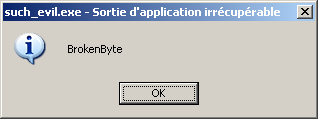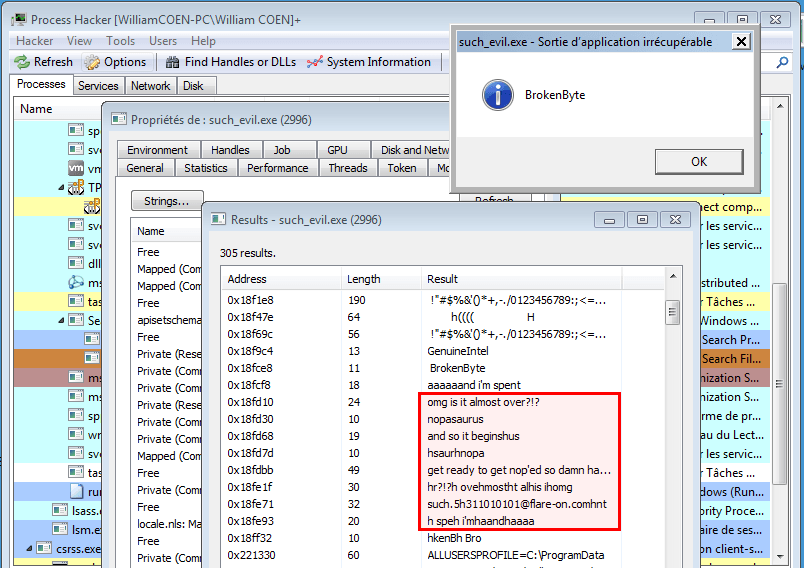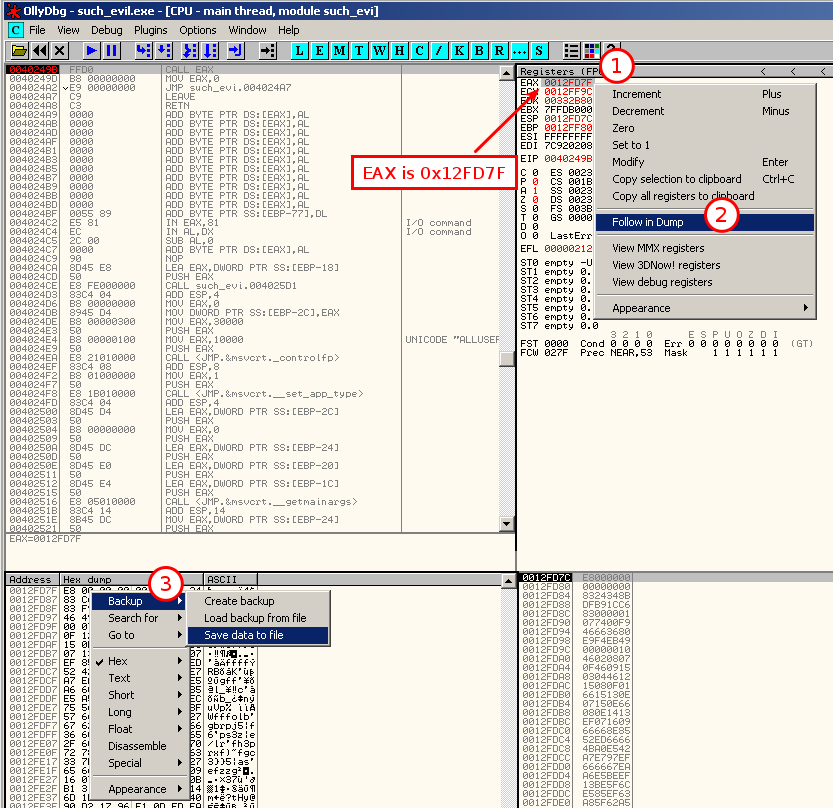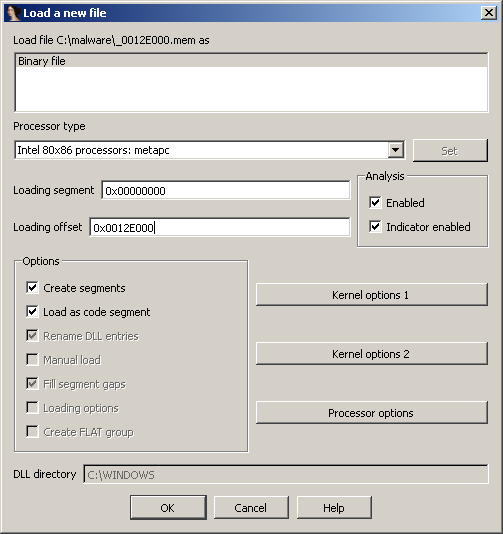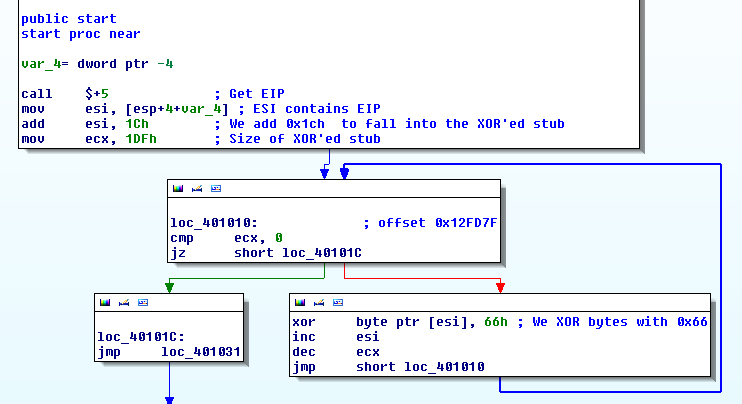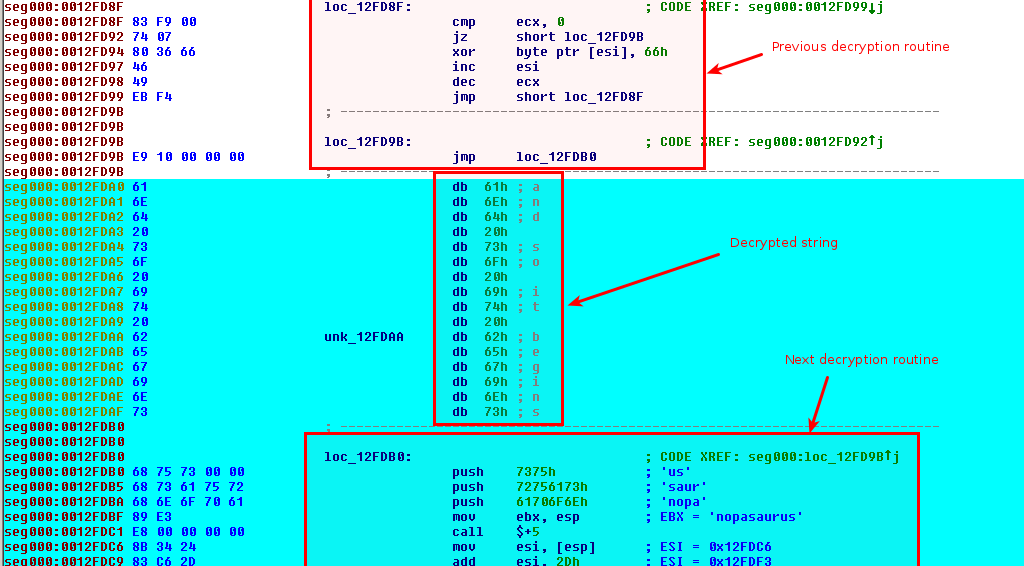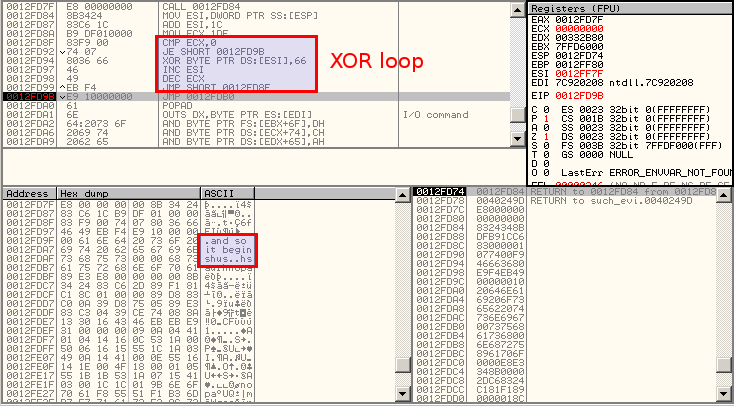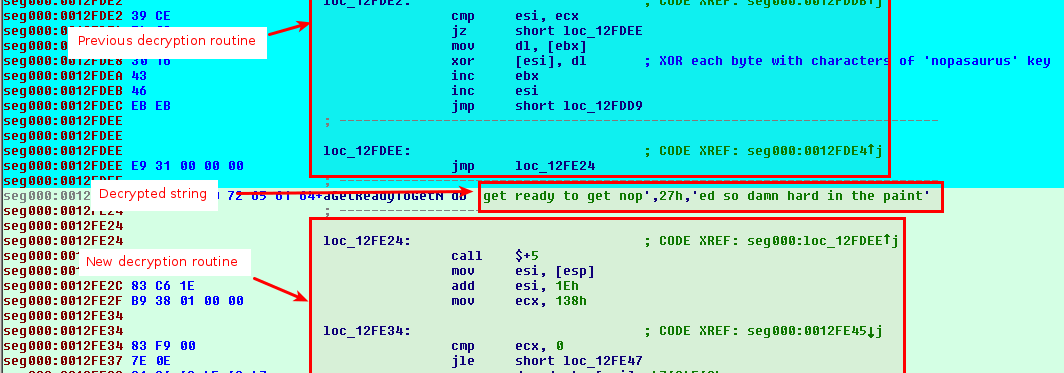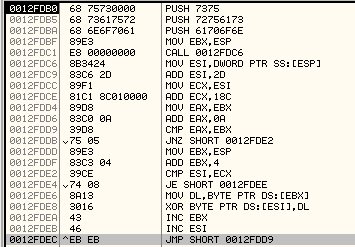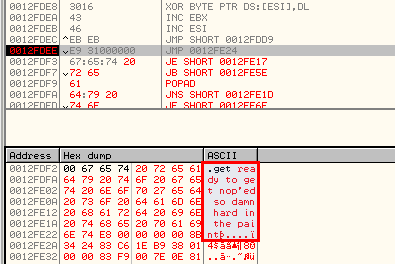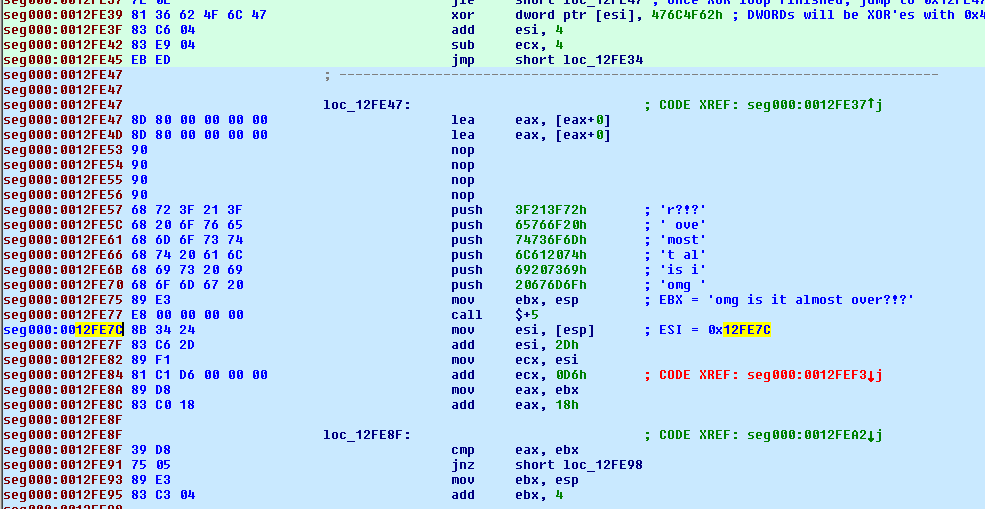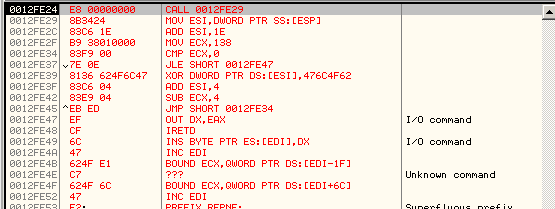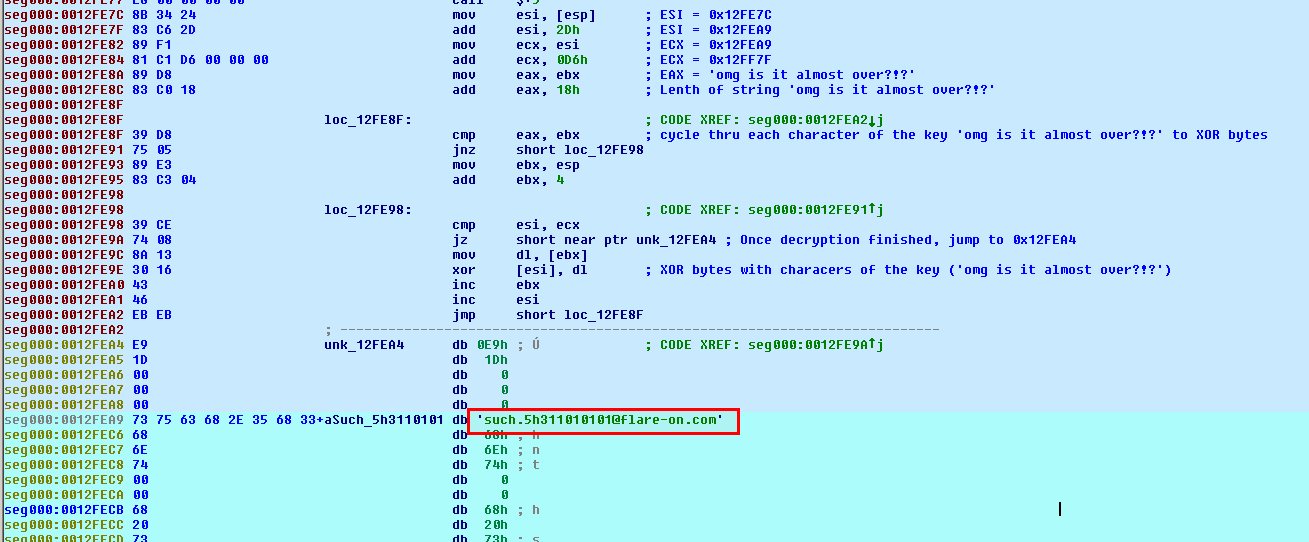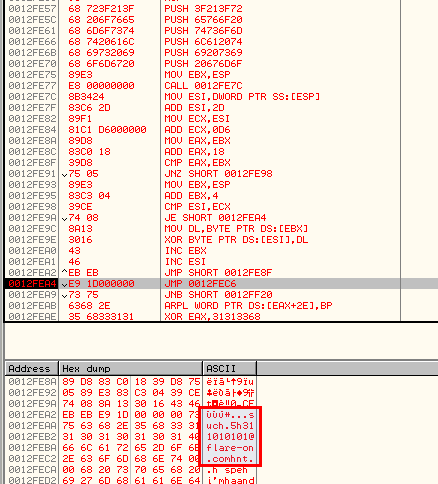The-FLARE-On-Challenge-01/Challenge-3
| You are here | Challenge 3
|
Uncompress the archive
Download the file: http://www.flare-on.com/files/C3.zip
Let's uncompress the archive:
$ 7z x C3.zip 7-Zip [64] 9.20 Copyright (c) 1999-2010 Igor Pavlov 2010-11-18 p7zip Version 9.20 (locale=fr_FR.utf8,Utf16=on,HugeFiles=on,4 CPUs) Processing archive: C3.zip Extracting such_evil Enter password (will not be echoed) : malware Everything is Ok Size: 7168 Compressed: 2713
We have an executable named "such_evil":
$ file such_evil such_evil: PE32 executable (console) Intel 80386 (stripped to external PDB), for MS Windows
$ md5sum such_evil f015b845c2f85cd23271bc0babf2e963 such_evil
Running the executable
When we execute it (you can rename it so that it has the *.exe extension), we can see the following message:
Also if we analyze the program in memory with ProcessHacker, we can notice several interesting strings, one of which looking like the email address we're looking for:

And so it begins
Shellcode identification
Let's disassemble the code into IDA Pro:
.text:004024EA call _controlfp
.text:004024EF add esp, 8
.text:004024F2 mov eax, 1
.text:004024F7 push eax
.text:004024F8 call __set_app_type
.text:004024FD add esp, 4
.text:00402500 lea eax, [ebp+var_2C]
.text:00402503 push eax
.text:00402504 mov eax, 0
.text:00402509 push eax
.text:0040250A lea eax, [ebp+var_24]
.text:0040250D push eax
.text:0040250E lea eax, [ebp+var_20]
.text:00402511 push eax
.text:00402512 lea eax, [ebp+var_1C]
.text:00402515 push eax
.text:00402516 call __getmainargs
.text:0040251B add esp, 14h
.text:0040251E mov eax, [ebp+var_24]
.text:00402521 push eax
.text:00402522 mov eax, [ebp+var_20]
.text:00402525 push eax
.text:00402526 mov eax, [ebp+var_1C]
.text:00402529 push eax
.text:0040252A call sub_401000
.text:0040252F add esp, 0Ch
.text:00402532 mov [ebp+Code], eax
.text:00402535 mov eax, [ebp+Code]
.text:00402538 push eax ; Code
.text:00402539 call exit
.text:00402539 start endp
We see an interesting call to sub_401000, which code is presented below:
.text:00401000 ; Attributes: bp-based frame
.text:00401000
.text:00401000 sub_401000 proc near
.text:00401000
.text:00401000 var_201 = byte ptr -201h
.text:00401000 var_200 = byte ptr -200h
.text:00401000 var_1FF = byte ptr -1FFh
.text:00401000 var_1FE = byte ptr -1FEh
[SNIP]
.text:00401000 var_3 = byte ptr -3
.text:00401000 var_2 = byte ptr -2
.text:00401000 var_1 = byte ptr -1
.text:00401000
.text:00401000 push ebp
.text:00401001 mov ebp, esp
.text:00401003 sub esp, 204h
.text:00401009 nop
.text:0040100A mov eax, 0E8h
.text:0040100F mov [ebp+var_201], al
.text:00401015 mov eax, 0
.text:0040101A mov [ebp+var_200], al
.text:00401020 mov eax, 0
.text:00401025 mov [ebp+var_1FF], al
.text:0040102B mov eax, 0
.text:00401030 mov [ebp+var_1FE], al
.text:00401036 mov eax, 0
[SNIP]
.text:0040247D mov eax, 95h
.text:00402482 mov [ebp+var_3], al
.text:00402485 mov eax, 0C9h
.text:0040248A mov [ebp+var_2], al
.text:0040248D mov eax, 0
.text:00402492 mov [ebp+var_1], al
.text:00402495 lea eax, [ebp+var_201]
.text:0040249B call eax
.text:0040249D mov eax, 0
.text:004024A2 jmp $+5
.text:004024A7 leave
.text:004024A8 retn
.text:004024A8 sub_401000 endp
Let's open the executable in OllyDbg and put a breakpoint on the "call eax" instruction at offset 0x0040249B. We'll run the program till this breakpoint and dump the stack memory to a file (right click on the EAX register, select "Follow in dump". Then from the memory dump window, right click and select "Backup > Save data to file"):
Open the resulting file ("_0012E000.mem") in IDA Pro, set the loading offset to "0012E000":
Go to offset "0x0012FD7F", right click and select "Code". The figure below depicts the 2 blocks: the code and the data to decrypt:
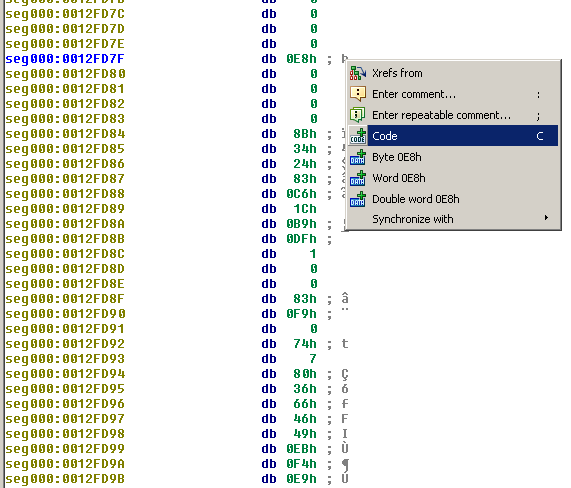
|

|
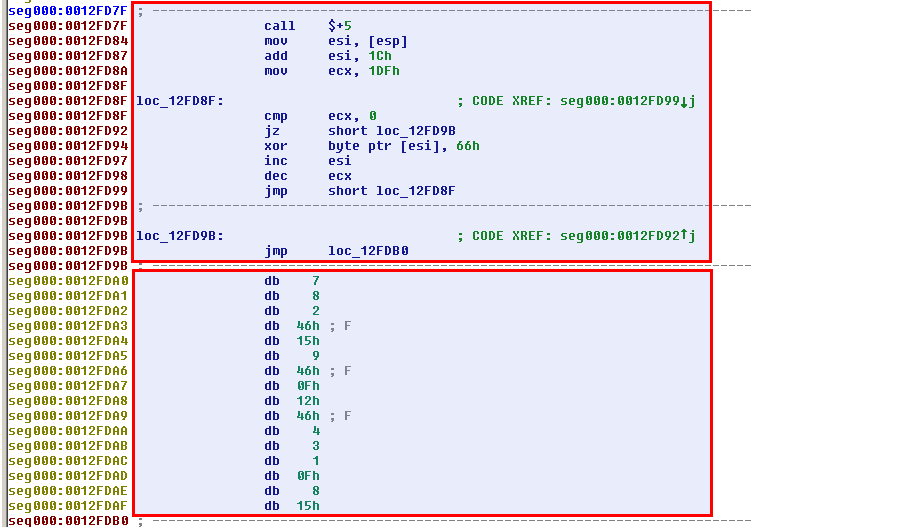
|
Here is what the code looks like (Note: I've used shellcode2exe to process the hexa export built from OllyDbg):
At this stage, can can either continue with the static analysis and write several python IDA scripts to uncrypt the code or perform a dynamic analysis in OllyDbg. Along this tutorial, we'll describe both approaches.
UnXOR with static analysis
We have already identified where the XOR'ed stub begins (offset 0x0012FDA0), the size of the stub (0x1DF) as well as the XOR key (0x66). Let's write a python script that we will load into IDA Pro:
loc = 0x12FDA0
for i in range(0x1DF):
b = Byte(loc+i)
decoded_byte = b ^ 0x66
PatchByte(loc+i, decoded_byte)
SetColor(loc+i, CIC_ITEM, 0xffff00)
To run the script, go to "File > Script file...". Here is the decoded text:
UnXOR with dynamic analysis
Let's put a breakpoint at the end of the XOR loop to decode the string. Here is what we see: "and so it begins".
get ready to get nop'ed so damn hard in the paint
Static Analysis
Once the previous decryption routine has run, it has decrypted the "and so it begins" string as well as new code that we can now analyze (it jumps to 0x12FDB0). Let's analyze the new decryption routine:
seg000:0012FDB0 loc_12FDB0: ; CODE XREF: seg000:loc_12FD9B�j
seg000:0012FDB0 68 75 73 00 00 push 7375h ; 'us'
seg000:0012FDB5 68 73 61 75 72 push 72756173h ; 'saur'
seg000:0012FDBA 68 6E 6F 70 61 push 61706F6Eh ; 'nopa'
seg000:0012FDBF 89 E3 mov ebx, esp ; EBX = 'nopasaurus'
seg000:0012FDC1 E8 00 00 00 00 call $+5
seg000:0012FDC6 8B 34 24 mov esi, [esp] ; ESI = 0x12FDC6
seg000:0012FDC9 83 C6 2D add esi, 2Dh ; ESI = 0x12FDF3
seg000:0012FDCC 89 F1 mov ecx, esi ; ECX = 0x12FDF3
seg000:0012FDCE 81 C1 8C 01 00 00 add ecx, 18Ch ; ECX = 0x12FF7F
seg000:0012FDD4 89 D8 mov eax, ebx ; EAX = 'nopasaurus'
seg000:0012FDD6 83 C0 0A add eax, 0Ah ; Length of 'nopasaurus' string
seg000:0012FDD9
seg000:0012FDD9 loc_12FDD9: ; CODE XREF: seg000:0012FDEC�j
seg000:0012FDD9 39 D8 cmp eax, ebx
seg000:0012FDDB 75 05 jnz short loc_12FDE2
seg000:0012FDDD 89 E3 mov ebx, esp
seg000:0012FDDF 83 C3 04 add ebx, 4
seg000:0012FDE2
seg000:0012FDE2 loc_12FDE2: ; CODE XREF: seg000:0012FDDB�j
seg000:0012FDE2 39 CE cmp esi, ecx
seg000:0012FDE4 74 08 jz short loc_12FDEE
seg000:0012FDE6 8A 13 mov dl, [ebx]
seg000:0012FDE8 30 16 xor [esi], dl ; XOR each byte with characters of 'nopasaurus' key
seg000:0012FDEA 43 inc ebx
seg000:0012FDEB 46 inc esi
seg000:0012FDEC EB EB jmp short loc_12FDD9
We can see the the string "nopasaurus" is used as a key array that will be used to XOR each byte starting from 0x12FDF3. Based on the analysis of this new decryption routine, we can write the following python code:
loc_start = 0x12FDF3
loc_end = 0x12FF7F
k = "nopasaurus"
c = 0
for loc in range(loc_start, loc_end):
b = Byte(loc)
x = k[c % (len(k))] # cycle thru the characters in the key
PatchByte(loc, b ^ ord(x))
SetColor(loc, CIC_ITEM, 0xE4FFD4)
c+=1
Once we run this script, here is what we get:
Dynamic Analysis
Then we have to deal with a second decoding loop:
The key "nopasaurus" is pushed to the stack:
At the end of the rountine, we can see "get ready to get nop'ed so damn hard in the paint" at offset 0x12FDD9:
omg is it almost over?!?
Static Analysis
The code now jumps to 0x12FE24 where we see a new decryption routine:
seg000:0012FE24 loc_12FE24: ; CODE XREF: seg000:loc_12FDEE�j
seg000:0012FE24 E8 00 00 00 00 call $+5
seg000:0012FE29 8B 34 24 mov esi, [esp] ; ESI = 0x12FE29
seg000:0012FE2C 83 C6 1E add esi, 1Eh ; ESI = 0x12FE47
seg000:0012FE2F B9 38 01 00 00 mov ecx, 138h ; Size of encrypted stub. Will be divided by 4 as we're dealing with DWORD
seg000:0012FE34
seg000:0012FE34 loc_12FE34: ; CODE XREF: seg000:0012FE45�j
seg000:0012FE34 83 F9 00 cmp ecx, 0
seg000:0012FE37 7E 0E jle short near ptr unk_12FE47 ; Once XOR loop finished, jump to 0x12FE47
seg000:0012FE39 81 36 62 4F 6C 47 xor dword ptr [esi], 476C4F62h ; DWORDs will be XOR'es with 0x476C4F62
seg000:0012FE3F 83 C6 04 add esi, 4
seg000:0012FE42 83 E9 04 sub ecx, 4
seg000:0012FE45 EB ED jmp short loc_12FE34
Once again, we can write a python code to decrypt the content. Notice that this time, we're not patching bytes but DWORDs.
loc = 0x12FE47
for i in range(0x138/4):
d = Dword(loc+i*4)
decoded_dword = d ^ 0x476C4F62
PatchDword(loc+i*4, decoded_dword)
for j in range(4):
SetColor(loc+i*4+j, CIC_ITEM, 0xFFE9C9)
Once the script is run, it shows a new decryption routine which key is the string "omg is it amost over?!?":
Dynamic Analysis
Then we have another loop:
which decrypts as: "omg is it almost over?!?":
Final loop and solution
Static Analysis
This new decryption routine is as follows:
seg000:0012FE57 68 72 3F 21 3F push 3F213F72h ; 'r?!?'
seg000:0012FE5C 68 20 6F 76 65 push 65766F20h ; ' ove'
seg000:0012FE61 68 6D 6F 73 74 push 74736F6Dh ; 'most'
seg000:0012FE66 68 74 20 61 6C push 6C612074h ; 't al'
seg000:0012FE6B 68 69 73 20 69 push 69207369h ; 'is i'
seg000:0012FE70 68 6F 6D 67 20 push 20676D6Fh ; 'omg '
seg000:0012FE75 89 E3 mov ebx, esp ; EBX = 'omg is it almost over?!?'
seg000:0012FE77 E8 00 00 00 00 call $+5
seg000:0012FE7C 8B 34 24 mov esi, [esp] ; ESI = 0x12FE7C
seg000:0012FE7F 83 C6 2D add esi, 2Dh ; ESI = 0x12FEA9
seg000:0012FE82 89 F1 mov ecx, esi ; ECX = 0x12FEA9
seg000:0012FE84 81 C1 D6 00 00 00 add ecx, 0D6h ; ECX = 0x12FF7F
seg000:0012FE8A 89 D8 mov eax, ebx ; EAX = 'omg is it almost over?!?'
seg000:0012FE8C 83 C0 18 add eax, 18h ; Lenth of string 'omg is it almost over?!?'
seg000:0012FE8F
seg000:0012FE8F loc_12FE8F: ; CODE XREF: seg000:0012FEA2�j
seg000:0012FE8F 39 D8 cmp eax, ebx ; cycle thru each character of the key 'omg is it almost over?!?' to XOR bytes
seg000:0012FE91 75 05 jnz short loc_12FE98
seg000:0012FE93 89 E3 mov ebx, esp
seg000:0012FE95 83 C3 04 add ebx, 4
seg000:0012FE98
seg000:0012FE98 loc_12FE98: ; CODE XREF: seg000:0012FE91�j
seg000:0012FE98 39 CE cmp esi, ecx
seg000:0012FE9A 74 08 jz short near ptr unk_12FEA4 ; Once decryption finished, jump to 0x12FEA4
seg000:0012FE9C 8A 13 mov dl, [ebx]
seg000:0012FE9E 30 16 xor [esi], dl ; XOR bytes with characers of the key ('omg is it almost over?!?')
seg000:0012FEA0 43 inc ebx
seg000:0012FEA1 46 inc esi
seg000:0012FEA2 EB EB jmp short loc_12FE8F
We can write a python script as follows:
loc_start = 0x12FEA9
loc_end = 0x12FF7F
k = "omg is it almost over?!?"
c = 0
for loc in range(loc_start, loc_end):
b = Byte(loc)
x = k[c % len(k)] # cycle thru the characters in the key
PatchByte(loc, b ^ ord(x))
SetColor(loc, CIC_ITEM, 0xFCFCAC)
c+=1
This last decryption routine reveals the email address we're looking for. We're done:
Dynamic Analysis
The final loop leads to the solution which is: "[email protected]":
Comments
Keywords: reverse-engineering challenge flare fireeye xor shellcode
